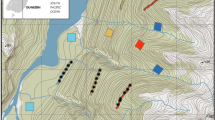Abstract
We created a model to study the process in which nutria(Myocastor coypus) feeding activities lead to erosion and loss of marsh area. This model ties together data on nutria population dynamics and feeding behavior from the literature with data from field studies on the phenology ofScirpus americanus andSpartina patens conducted in the Barataria Basin, Louisiana, USA in 1992. The complete model consists of three linked models: a model of nutria population dynamics (nutria model), a model of the annual marsh biomass cycle ofScirpus americanus andSpartina patens (biomass model), and a plant-biomass densitydependent marsh area model (area model). When all three models are linked together, they form the nutria-biomass-area model.” Analysis of the models indicated the following. (1) The high population densities and low survivorship rates as reported in the literature are incompatible. (2) The nutria model is sensitive to adult and juvenile survivorship and, to a lesser extent, young born per female. It is not particularly sensitive to gestation periods, impregnation rates, or time to maturity. (3) The marsh area model is not sensitive to the marsh loss equation nor to the density at which loss of marsh area begins but is sensitive to the amount of biomass destroyed per nutria. (4) Nutria numbers do not significantly decrease in the nutria-biomass-area model until the total marsh area approached zero because marsh loss occurs only during winter when marsh biomass is at its annual low.
Similar content being viewed by others
Literature Cited
Atwood, E. L. 1950. Life history studies of nutria, or coypu, in coastal Louisiana. Journal of Wildlife Management 14:249–265.
Carter, J., A. L. Foote, and L. A. Johnson. 1998. Nutria model. U.S. Geological Survey, National Wetlands Research Center, http://www.nwrc.usgs.gov/nutria/readme.htm.
Coreil, P.D. 1976. Habitat preferences, movements, and activities of adult female nutria in a southwestern Louisiana intermediate marsh area. M.S. Thesis. Louisiana State University, Baton Rouge, LA. USA.
Ehrlich, S. 1962. Two experiments in inducing nutria aggregation in unfenced artificial ponds. Hydrobiologia 19:316–333.
Evans, J. 1970. About nutria and their control. Bureau of Sport Fisheries and Wildlife, Denver, CO, USA. Resource Publication 86.
Foote, A. L. and L. A. Johnson. 1993. Plant stand development in Louisiana coastal wetlands: nutria grazing effects on plant biomass. p. 265–269. In M.C. Landin (ed.) Wetlands: Proceedings of the 13th Annual Conference of the Society of Wetland Scientists, New Orleans, LA. South Central Capter, Society of Wetland Scientists, Utica, MS, USA.
Gosling, L. M., S. J. Baker, and J. R. Skinner. 1983. A simulation approach to investigating the response of a coypu population to climatic variation. EPPO Bulletin 13:183–192.
Gosling, L. M. and S. J. baker. 1989. Demographic consequences of differences in the ranging behaviour of male and female coypus. p. 155–224. In R.J. Putman (ed.) Mammals as Pests. Chapman and Hall. New York, NY, USA.
Harris, V. T. and F. Webert. 1962. Nutria feeding activity and its’ effect on marsh vegetation in southwestem Louisiana. U. S. Fish and Wildlife Service, Washington, DC, USA, Special Scientific Report Wildlife 64.
High Performance Systems Inc. 1994. STELLA II, High Performance Systems Inc. Hanover, NH, USA.
Johnson, L. A. and A. L. Foote. 1997, Vertebrate herbivory in managed coastal wetlands: a manipulative experiment. Aquatic Botany 59:17–32.
Kinler, N. W., G. Linscombe, and P. R. Ramsey. 1987. Nutria. p. 327–343. In M. Novak, J. Baker, M. Obbard, and B. Malloch (eds.) Wild Furbearer Management and Conservation in North America. The Ontario Trappers Association, Toronto, Ontario, Canada.
Linscombe. G., N. Kinler, and V. Wright. 1981. Nutria population density and vegetative changes in brackish marsh in coastal Louisiana. p. 129–141. In J. A. Chapman and D. Pursley (eds.) Proceedings of the Worldwide Furbearer Conference, Frostburg, MD, USA.
Linscombe, G. and N. Kinier. 1997. A Survey of Vegetative Damage Caused by Nutria Herbivory in the Barataria and Terrebonne Basins. Barataria-Terrebone National Estuary Program, Nicholls State University, Thibodaux, LA, USA,
Newson, R. M. 1969. Population dynamics of the coypu,Myocastor, coypus (Molina), in eastern England. p. 203–204. In K. Petrusewicz and L. Ruszkowski (eds.) Energy Flow through Small Mammal Populations. IBP Publishers, Oxford, UK.
Nowak, R. M. (ed.) 1991. Walker’s mammals of the World, 5th Edition, Volume 2. John Hopkins University Press, Baltimore, MD, USA.
Reggiani, G., L. Boitain and R. De Stefano. 1995. Population dynamics and regulation in the coypuMyocastor coypus in central Italy. Ecography 18:138–146.
Starfield, A. M. 1997. A pragmatic approach to modeling for wildlife management. Journal of Wildlife Management 61:261–270.
Willner, Gale R. 1982. Nutria. p. 1059–1076. In J. A. Chapman and G. A. Feldhammer (eds.) Wild Mammals of North America. John Hopkins University Press, Baltimore, MD, USA.
Author information
Authors and Affiliations
Rights and permissions
About this article
Cite this article
Carter, J., Foote, A.L. & Johnson-Randall, A. Modeling the effects of nutria(Myocastor coypus) on wetland loss. Wetlands 19, 209–219 (1999). https://doi.org/10.1007/BF03161750
Received:
Revised:
Accepted:
Issue Date:
DOI: https://doi.org/10.1007/BF03161750




